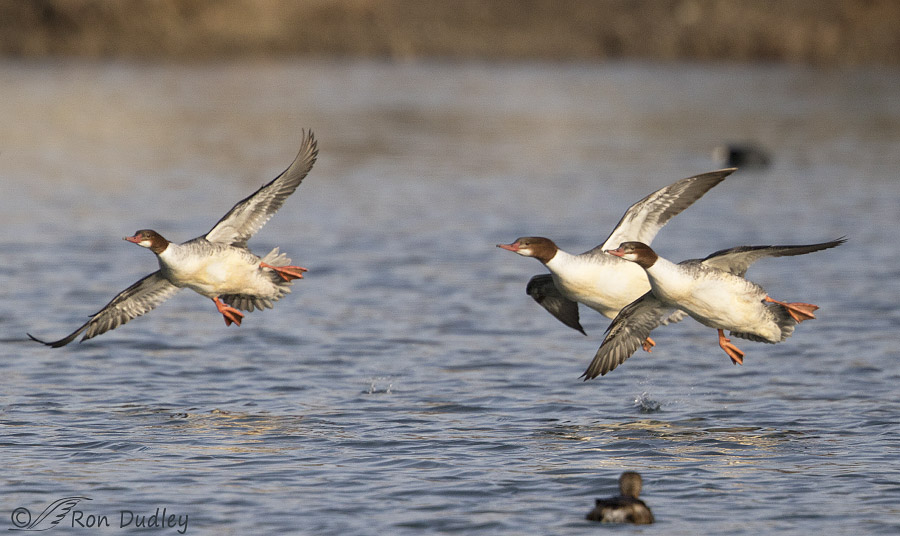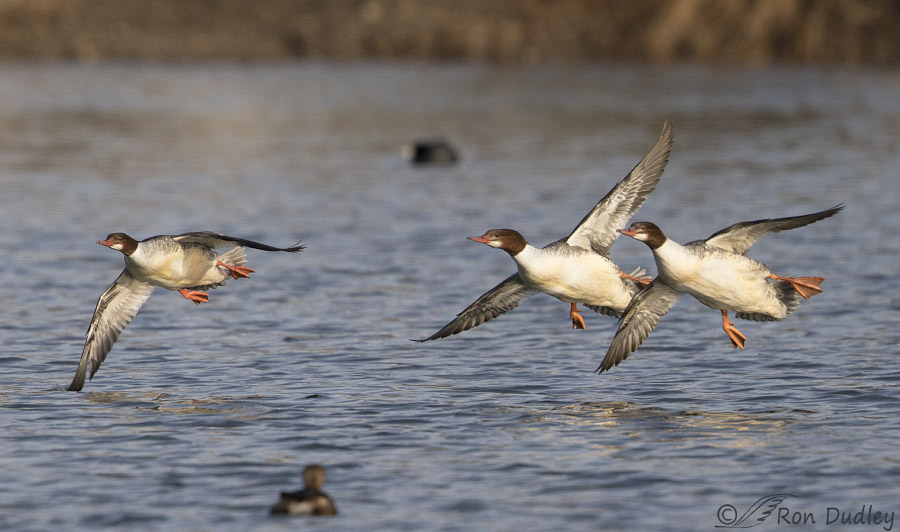Common Mergansers are fast fliers so yesterday I was happy to get multiple shots of three of them in flight.

1/3200, f/6.3, ISO 640, Canon 7D Mark II, Canon EF 500mm f/4L IS II USM + EF 1.4 III Extender, not baited, set up or called in
There were actually four mergansers in this group as they approached the pond from my left but I never did get all four birds in frame while they were still high in the air. As they descended they looped around the pond and came in to land in the opposite direction and into the north breeze. Their relatively heavy bodies and very narrow wings are indicative of their typical fast flight which averages about 44 mph, making them a difficult subject for the photographer while they’re in flight.
These six images were taken in a quick burst lasting .6 seconds and there are no skips in the series. All of the photos are similar to each other but I thought it was interesting to note their subtle differences in flight posture as they skimmed low over the water while they were still in a slight banking turn and traveling very fast.

1/4000, f/6.3, ISO 640, Canon 7D Mark II, Canon EF 500mm f/4L IS II USM + EF 1.4 III Extender, not baited, set up or called in
I enjoy the splayed feet of the bird on the right as its right wing actually clips the water’s surface.

1/4000, f/6.3, ISO 640, Canon 7D Mark II, Canon EF 500mm f/4L IS II USM + EF 1.4 III Extender, not baited, set up or called in
There are a lot of birds on the pond so the mergansers now had an audience – a Pied-billed Grebe and a coot. They would have been easy to remove but I chose not to.
1/4000, f/6.3, ISO 640, Canon 7D Mark II, Canon EF 500mm f/4L IS II USM + EF 1.4 III Extender, not baited, set up or called in
Now it’s the merganser on the left whose wing is clipping the water.
I always find it interesting to note how far birds in flight have traveled between sequential camera clicks. In three of these photos the grebe and the coot serve as “place markers” to…

1/4000, f/6.3, ISO 640, Canon 7D Mark II, Canon EF 500mm f/4L IS II USM + EF 1.4 III Extender, not baited, set up or called in
give us some indication of that distance.

1/3200, f/6.3, ISO 640, Canon 7D Mark II, Canon EF 500mm f/4L IS II USM + EF 1.4 III Extender, not baited, set up or called in
This is the last shot I got before I lost focus on the birds. With them so close to the water I was happy to get them relatively sharp for as long as I did.
The fourth merganser in the group was actually right in front of these birds and in several of these photos I had part of that bird in frame. In order to achieve an acceptable composition and remove the distracting fragments of bird from the photos I chose to clone that bird out. I also removed a very bright-white and out of focus gull in one of the images – that bright spot hurt my eyes. Cloning is something I don’t like to do but right or wrong I chose to make an exception for this series.
I enjoy seeing the mergansers back on the pond – it’s been a while. I just hope they can avoid becoming entangled in fishing line and snagged by discarded hooks while they’re here. Four years ago I documented some mergansers on this pond who weren’t so lucky.
Ron
PS – I had a very refreshing experience on the pond yesterday afternoon soon after photographing these mergansers. I always groan when fishermen pull into the parking lot because they always seem to fish from shore very close to my pickup (my “mobile blind”) and keep or scare the birds away. The fishermen tend to be oblivious to the concerns of photographers.
As one fisherman approached the pond he walked right between me and the birds and I thought “here we go again!”.
But this fellow was refreshingly different. He asked me where he could fish from on shore that wouldn’t interfere with our attempts at photographing birds (he’d obviously noticed our long lenses sticking out of the windows). He said that he’s a serious photographer himself (he photographs “people”) and he understands the challenges we face in situations like the pond. He listened to my response and then chose a fishing spot that worked for both him and us.
My opinion of my fellow man improved significantly during that encounter. Thank you, sir!



Though I often look, I rarely take the time to comment lately as I am a student or in training for job. I wish you many opportunities for capturing those wonderful images next year.
These Mergansers look like a well choreographed ballet to me. Glad you had a good experience with that fisherman!
wonderful series Ron!
Charlotte
Thanks, Charlotte.
Where to start…
Love the proof positive that one doesn’t need to be svelte to be beautiful.
In awe at the precision group flying.
And really chuffed to hear that you met someone who was prepared to give you room so that you could BOTH enjoy the day.
So was I, EC. That kind of considerate behavior is unusual enough these days that it was completely unexpected and much appreciated.
Beautiful. I love mergansers, maybe it’s a redhead thing. I am so jealous of your nearby pond! I spent the afternoon trying to photograph wild turkeys in the snow. What a challenge on a sunny day! None of my photos turned out well, I think I will try again today if I can find the birds. A co-worker told me about them, she sees them everyday as she drives to work. It took me 3 attempts to locate them. Unfortunately due to the canyon they live in the sun is not out until noon to 3 so the light is harsh. Between the “blinkies and lost detail in the dark feathers it almost made me give up photography!
That sounds like an extremely difficult exposure situation, April. I’ve never had very good luck with turkeys even in good light!
Don’t be too jealous of the pond. Between terrible light angles, no interesting birds (mostly domestic mixes) and rude fishermen and crowds it usually takes me about a dozen trips down there to get any interesting shots at all.
Typically I just show up and then leave immediately.
You are amazing Ron! I find it hard to get the Common Merganser swimming let alone in flight, they are too darned fast for me. Thank you so much for this post…at last I get to see the underside of this amazing species.
Shirley, Believe me, usually they’re too fast for me too.
As a fellow member of the “chunky body/short arms brigade,” I find these birds quite lovely and graceful. The wing dipping reminds me of the way speed skaters touch the ice on a turn. The audience members provide good reference points too; I’m glad you left them in. And yay for the polite fisherman — hopefully, he had a reel with him.
The wing dipping reminds me of the way speed skaters touch the ice on a turn. The audience members provide good reference points too; I’m glad you left them in. And yay for the polite fisherman — hopefully, he had a reel with him. 
Yes, he had a real reel, Marty.
And you’re right about speed skaters.
Gorgeous images! I’m really struck by the synchronized flying, landing, dipping wings in the water, etc. of this trio! It’s that flock thing that boggles my mind in the how-do-they-do-that department. I’m also thankful that you’re helping me with my duck ID. I’m good with mallards and coots, but after that, my IQ points plummet.
LOL! Yeah, “chunky.” Or maybe fluffy? Yeah, fluffy works, too, especially if you’ve ever tried to prepare a hawk-caught duck for Christmas dinner. If I’d have had an operational brain cell while I was living in Wyoming and Mariah was catching ducks, I’d have saved all that down to make my own down comforter! Alas, no. Sigh!
Laura, I plucked a duck once when I was a kid. I never saw so many feathers in my life!
Those feathers keep ducks warm and dry, so they’re pretty spectacular. Feathers are spectacular! Jack collected a big BUNCH of cactus needles on his back, but those just fell off. I want feathers–like a hawk. Harrumph!
And nasty to deal with if you want to “try” to make down anything!
They look choreographed…beautiful…especially the first ones……
I agree, Patty – synchronized flight, almost.
One of the miracles of multiple bird flight…
Loved story of fisherman…his thoughtfulness was so unusual and refreshing these days (sad but true!) it gave my saggy spirits a real rise. It was gift just to hear about him….and remind myself that in these nightmarish, self-centered, trumpian times that people like him still exist….
That guy made my day.
I bet he did make your day! I know I would have asked where I could be so as to give you what you need. I’m not a photographer BUT I’ve worked with a bunch of them. I see a camera, I get out of its way! But so many humans would have been oblivious to your presence and objectives!
Very different from the delbiberately obnoxious dog walker who very purposefully stood in front of your camera to block your shot….
Wonderful series, Ron! I’ve never thought of the female mergansers being “thick bodied” probably because I usually only see them on the water, going like hell with a brood on their backs, or their butts flying fast and furious away from me! Males, yes. Kudo’s to the fisherman who understood the issues and consulted with you even if he didn’t need to!
I’ve never thought of the female mergansers being “thick bodied” probably because I usually only see them on the water, going like hell with a brood on their backs, or their butts flying fast and furious away from me! Males, yes. Kudo’s to the fisherman who understood the issues and consulted with you even if he didn’t need to!  A VERY productive day!
A VERY productive day! 
“I’ve never thought of the female mergansers being “thick bodied””
I agree, Judy – while they’re on the water they look very streamlined. They seem to be a little like Western Grebes in that regard. While the grebes are on the water they appear sleek and streamlined but when they raise up in the water to “shake” it becomes apparent that they’re very chunky.